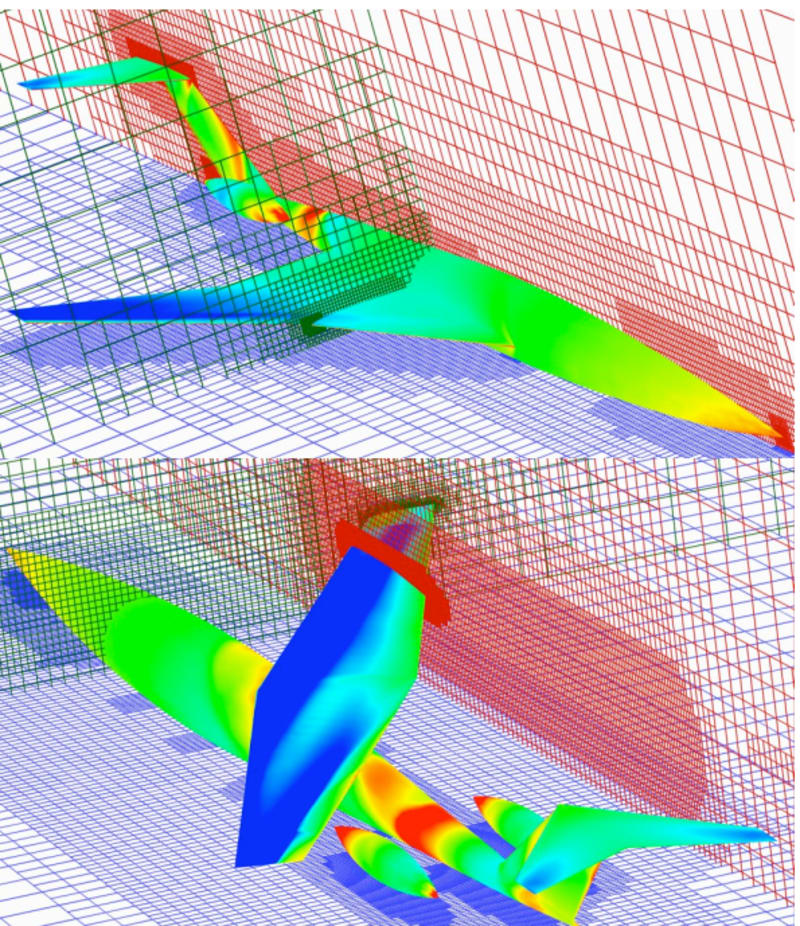Oblique Wing research-driven design addresses the aerodynamic inefficiencies of conventional symmetric wing configurations at high-speed flight regimes by proposing a structurally optimized oblique wing (OW) configuration. Unlike conventional sweep-back designs, the OW incorporates a single-pivot, asymmetric wing structure capable of variable sweep adjustment, aimed at minimizing drag and maximizing lift-to-drag (CL/CD) ratios in both subsonic and supersonic regimes.The core problem tackled is the high wave drag encountered in transonic and supersonic flight, which significantly limits fuel efficiency and operational range. Our proposed OW structure provides a novel solution by distributing lift more evenly over the span and significantly reducing wave drag (up to 4x lower) and volumetric wave interference (up to 16x lower) through directional asymmetry.
A comprehensive multidisciplinary design optimization (MDO) process was employed. Initial low-fidelity aerodynamic models were used to explore the design space, followed by high-fidelity simulations using ANSYS Fluent. Complex flow characteristics, including local Mach variations and shockwave interactions, were captured via Euler-based CFD analyses. Mesh generation and flow resolution were calibrated to ensure convergence and accuracy in key metrics such as drag coefficients and pressure distributions.
Designs were evaluated using the PASS (Preliminary Aircraft Sizing Software) platform, which integrates mission performance, takeoff field length, and climb gradients into constraint-based optimization. A response surface methodology (RSM) was implemented to interpolate CFD-derived aerodynamic data, enabling rapid iteration across design variables. Additional constraints were applied to pitch, yaw, and roll moment coefficients to ensure stability and control, particularly under high sweep asymmetry.The OW design presented novel challenges, including asymmetric flow conditions across the fore and aft wing halves, leading to local supersonic regions and high shock strength on the aft section. To mitigate this, parametric dihedral modifications were applied manually to flatten upper surface curvature and reduce root flow separation. These refinements yielded a performance increase over conventional wings under comparable mission profiles.Mass and CG estimation followed established statistical models calibrated with jet-class aircraft data. The wing’s structural weight included a 10% mass penalty to account for the pivot mechanism, extrapolated from Boeing-scale references. Thrust modeling was based on Mach-altitude performance mapping, with engines integrated into the fuselage to maintain symmetry under varying wing angles.Low-speed aerodynamic behavior was assessed using the Discrete Vortex Method (DVM), particularly for takeoff and landing phases. OW configurations showed favorable stability derivatives and improved lift coefficients compared to conventional layouts.The final optimization loop, incorporating aerodynamic performance, structural feasibility, mission analysis, and energy efficiency, led to the definition of a next-generation oblique wing platform.
This design offers transformative potential for both civil and military applications by improving fuel efficiency, reducing emissions, and enabling faster, longer-range missions. Its modular nature supports scalable production with comparable costs to legacy variable-sweep technologies but with significantly enhanced aerodynamic efficiency.o validate aerodynamic assumptions, a low-fidelity prototype was constructed using foamboard and wood, with servo-actuated pivot mechanisms. For high-fidelity testing, a composite and LW Engineering PLA-based prototype of the fuselage and wings is planned to ensure structural accuracy, surface fidelity, and aerodynamic validation through high-speed wind tunnel experimentation.
Like this entry?
-
About the Entrant
- Name:Muhammet Akin Avci
- Type of entry:teamTeam members:
- Sultan Dilan Teğin
- Software used for this entry:In support of the adaptive wing system, a suite of software tools was developed to analyze aerodynamic performance and control the oblique pivot mechanism. MATLAB was used extensively to process wind tunnel data, enabling the calculation of aerodynamic coefficients such as lift, drag, and pitching moment across a range of Mach numbers and sweep angles. A custom script was implemented to automatically extract and organize these parameters into a response surface model, facilitating rapid design iteration and mission performance analysis. To ensure the pivot mechanism responds accurately to dynamic flight conditions, a control algorithm was designed using real-time velocity data as input. A block diagram of the control logic was created to simulate and validate the mechanism's performance across subsonic and supersonic regimes. During sensor integration, significant signal noise was observed in IMU data. Various digital filtering techniques were tested—including Kalman, Median, and Savitzky-Golay filters—with the latter selected for its superior performance in preserving signal trends while minimizing noise. Ongoing development focuses on enhancing the real-time responsiveness of the pivot system and improving robustness at high dynamic pressures. These software modules form the backbone of an intelligent control architecture that allows the oblique wing to adaptively optimize its configuration for fuel efficiency, stability, and aerodynamic performance in varying flight conditions.
- Patent status:none









